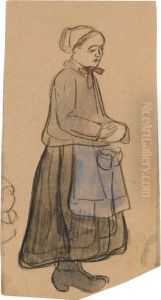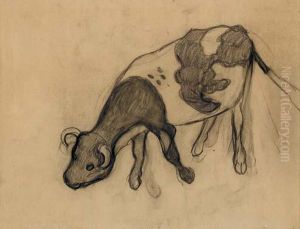Mogens Ballin Paintings
Mogens Ballin was a Danish artist and close associate of the group of painters known as the Symbolists. He was born on April 5, 1871, in Copenhagen, Denmark, into a Jewish family. His early interest in art led him to study at the Royal Danish Academy of Fine Arts, although his artistic career is often defined by his connections and friendships with other prominent artists of his time, rather than any formal training he received.
Ballin was particularly influenced by his friendship with the French artist Paul Gauguin, who he met in Brittany. This relationship had a significant impact on the development of his artistic style, which began to incorporate Symbolist and Synthetist elements characteristic of Gauguin's work. Ballin is known for his use of simplified forms and symbolic content. However, his body of work was not limited to painting; he also dabbled in metalwork and other decorative arts, showing versatility in his artistic endeavors.
In 1893, Ballin converted to Catholicism, and his faith became a central theme in his art. His works often explored religious motifs and the human condition, reflecting his personal spiritual journey. Despite his conversion, Ballin continued to face antisemitism, which affected both his personal life and his professional career.
Apart from his artistic pursuits, Mogens Ballin was also a central figure in the Danish artistic community and played a role in introducing modern French art to Denmark. He opened a workshop in Copenhagen, which became a gathering place for artists and an epicenter for the exchange of ideas and promotion of modern art trends within the Danish art scene.
Sadly, Ballin's life was cut short when he died on January 14, 1914, in Copenhagen. Although his career was relatively brief, his contributions to the Danish Symbolist movement and his efforts to bridge Danish and French art left a lasting imprint on the cultural landscape of Denmark. Ballin's work is represented in various Danish museums and collections, where it continues to be appreciated by art historians and enthusiasts alike.

